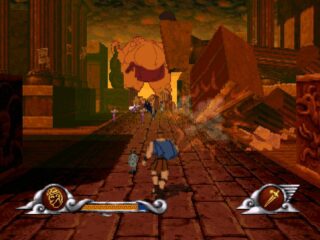Wonder Boy in Monster World is an action-adventure platformer developed by Westone and released in 1991 by Sega for the Genesis/Mega Drive. This fourth entry in the Wonder Boy series combines RPG elements inspired by early Zelda titles with free exploration that makes it an early example of the metroidvania platformer genre, creating a unique hybrid that bridges the gap between Wonder Boy in Monster Land and Wonder Boy III: The Dragon's Trap.
The game follows Shion, a young warrior who must save Monster World from the evil BioMeka forces that have invaded and corrupted the land. Unlike the linear progression of earlier entries, Wonder Boy in Monster World embraces a more open-ended structure that encourages exploration and backtracking as players acquire new abilities and equipment. This approach draws heavily from the Zelda series' dungeon-crawling formula while maintaining the side-scrolling perspective that defined the Wonder Boy franchise.
The RPG elements represent a significant evolution from previous Wonder Boy games, incorporating experience points, multiple weapons and armor sets, and magic spells that can be purchased from shops throughout the world. Players can upgrade Shion's sword, acquire different types of armor, and learn various magical abilities that not only aid in combat but also serve as keys to accessing previously unreachable areas. This progression system feels more sophisticated than the transformation mechanics of Wonder Boy III: The Dragon's Trap, though it lacks the creative variety that made that game's animal forms so memorable.
Visually, Monster World showcases the Mega Drive's capabilities with detailed sprite work and colorful environments that bring the fantasy world to life. The character animations are smooth and expressive, while the diverse locations range from lush forests to mechanical fortresses, each with distinct visual themes that make exploration rewarding. The art style maintains the series' whimsical charm while introducing darker, more serious elements that reflect the game's more mature narrative approach compared to earlier entries.
The exploration mechanics form the game's strongest element, with an interconnected world map that gradually opens up as players gain new abilities. Secret passages, hidden treasures, and optional areas reward thorough exploration, making each return trip to familiar locations potentially revealing new discoveries. This design philosophy clearly influenced later metroidvania titles and demonstrates how effectively the Wonder Boy series adapted to evolving player expectations for non-linear gameplay.
Combat feels more tactical than previous entries, requiring players to consider enemy patterns, weapon ranges, and magical abilities rather than relying purely on reflexes. The variety of enemies and bosses provides consistent challenges throughout the adventure, though some encounters can feel repetitive during extended play sessions. The magic system adds strategic depth, with spells like healing, fire attacks, and protective barriers that must be managed carefully due to limited magic points.
The audio design features a memorable soundtrack composed by Shinichi Sakamoto that perfectly captures the game's adventurous spirit. The musical themes range from heroic overworld melodies to atmospheric dungeon tracks that enhance the exploration experience. Sound effects provide satisfying feedback for combat and interaction, though they lack the distinctive personality that made earlier Wonder Boy games so instantly recognizable.
While Wonder Boy in Monster World represents an ambitious and largely successful evolution of the series formula, it doesn't quite reach the creative heights of Wonder Boy III: The Dragon's Trap or achieve the refined perfection that would make Monster World IV such a masterpiece three years later. The game occasionally suffers from pacing issues during its middle sections, and some of the RPG mechanics feel underdeveloped compared to dedicated role-playing games of the era.
Despite these minor shortcomings, Wonder Boy in Monster World remains one of the most beloved titles in the Genesis/Mega Drive library, offering a substantial adventure that successfully bridges multiple genres. The game's influence on the metroidvania genre cannot be overstated, as it demonstrated how traditional platforming could be enhanced through RPG progression and interconnected world design. For fans of exploration-based adventures and anyone interested in the evolution of the Wonder Boy series, Monster World provides an engaging and historically significant gaming experience that showcases Westone's innovative approach to genre blending during the 16-bit era.












